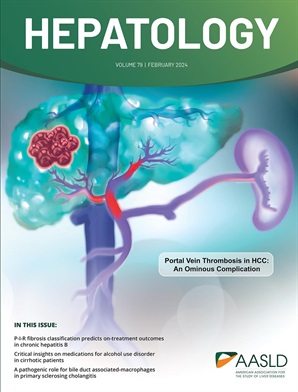抗血管生成治疗联合免疫检查点阻断介导CCR7+CD8+ t细胞通过高内皮小静脉进入HCC
IF 12.9
1区 医学
Q1 GASTROENTEROLOGY & HEPATOLOGY
引用次数: 0
摘要
背景,目的:肝细胞癌(HCC)仍然是中国癌症死亡的主要原因。抗血管生成药物(AADs) +免疫检查点阻断(ICB)联合治疗HCC显示出相当大的前景;然而,其疗效受到肿瘤微环境内免疫抑制的阻碍。高内皮小静脉(HEVs)促进淋巴细胞迁移和肿瘤浸润。目的是研究hev的形成、功能机制和联合治疗HCC的临床相关性。的方法,结果:单核RNA测序、流式细胞术和免疫组织化学显示,AAD和ICB联合治疗后,HCC组织中HEV表达增加,CD3 + t细胞浸润增加。多重免疫组织化学和空间分析表明,CCR7 + CD8 + T细胞与hev存在空间相关性。采用人T细胞伪时间分析和CCR7+CD8+ T细胞输注治疗Hepa1-6原位肝肿瘤小鼠模型,结果表明CCR7+CD8+ T细胞可分化为细胞毒性效应T细胞。同样的模型表明,联合治疗激活了VEGFC和非典型NF-κB通路,促进了HEV的形成。Kaplan-Meier分析显示,高HEV密度与改善的临床反应和延长的生存期相关。结论:hev在调节HCC肿瘤微环境中的免疫活性中起关键作用。靶向vegf - nf -κ b(非规范)- hev轴可能是一种有希望的治疗策略,可以增强接受AAD + ICB联合治疗的HCC患者的抗肿瘤免疫和改善预后。本文章由计算机程序翻译,如有差异,请以英文原文为准。
Antiangiogenic therapy combined with immune checkpoint blockade mediates CCR7+CD8+ T-cell entry into HCC through high endothelial venules
Background & Aims: Hepatocellular carcinoma (HCC) remains a leading cause of cancer mortality in China. Anti-angiogenic drugs (AADs) plus immune checkpoint blockade (ICB) combination therapy shows considerable promise for HCC; however, its efficacy is hampered by immunosuppression within the tumor microenvironment. High endothelial venules (HEVs) facilitate lymphocyte migration and tumor infiltration. The aim was to study the formation, functional mechanisms, and clinical relevance of HEVs in the treatment of HCC with combination therapy. Approach & Results: Single-nucleus RNA sequencing, flow cytometry, and immunohistochemistry revealed increased HEV expression and higher CD3⁺ T-cell infiltration in HCC tissue after combination AAD and ICB therapy. Multiplex immunohistochemistry and spatial analysis demonstrated that CCR7⁺CD8⁺ T cells were spatially associated with HEVs. Pseudotime analysis of human T cells and treatment of Hepa1-6 orthotopic liver tumor mouse models with CCR7+ CD8+ T-cell transfusions were used to show that CCR7+ CD8+ T cells can differentiate into cytotoxic effector T cells. The same models demonstrated that combination therapy activated VEGFC and non-canonical NF-κB pathways, promoting HEV formation. Kaplan-Meier analysis revealed that high HEV density correlated with improved clinical response and prolonged survival. Conclusions: HEVs are pivotal in modulating immune activity within the HCC tumor microenvironment. Targeting the VEGFC–NF-κB (non- canonical)–HEV axis could be a promising therapeutic strategy to enhance antitumor immunity and improve outcomes in patients with HCC who are receiving combination AAD plus ICB therapy.
求助全文
通过发布文献求助,成功后即可免费获取论文全文。
去求助
来源期刊

Hepatology
医学-胃肠肝病学
CiteScore
27.50
自引率
3.70%
发文量
609
审稿时长
1 months
期刊介绍:
HEPATOLOGY is recognized as the leading publication in the field of liver disease. It features original, peer-reviewed articles covering various aspects of liver structure, function, and disease. The journal's distinguished Editorial Board carefully selects the best articles each month, focusing on topics including immunology, chronic hepatitis, viral hepatitis, cirrhosis, genetic and metabolic liver diseases, liver cancer, and drug metabolism.
 求助内容:
求助内容: 应助结果提醒方式:
应助结果提醒方式:


